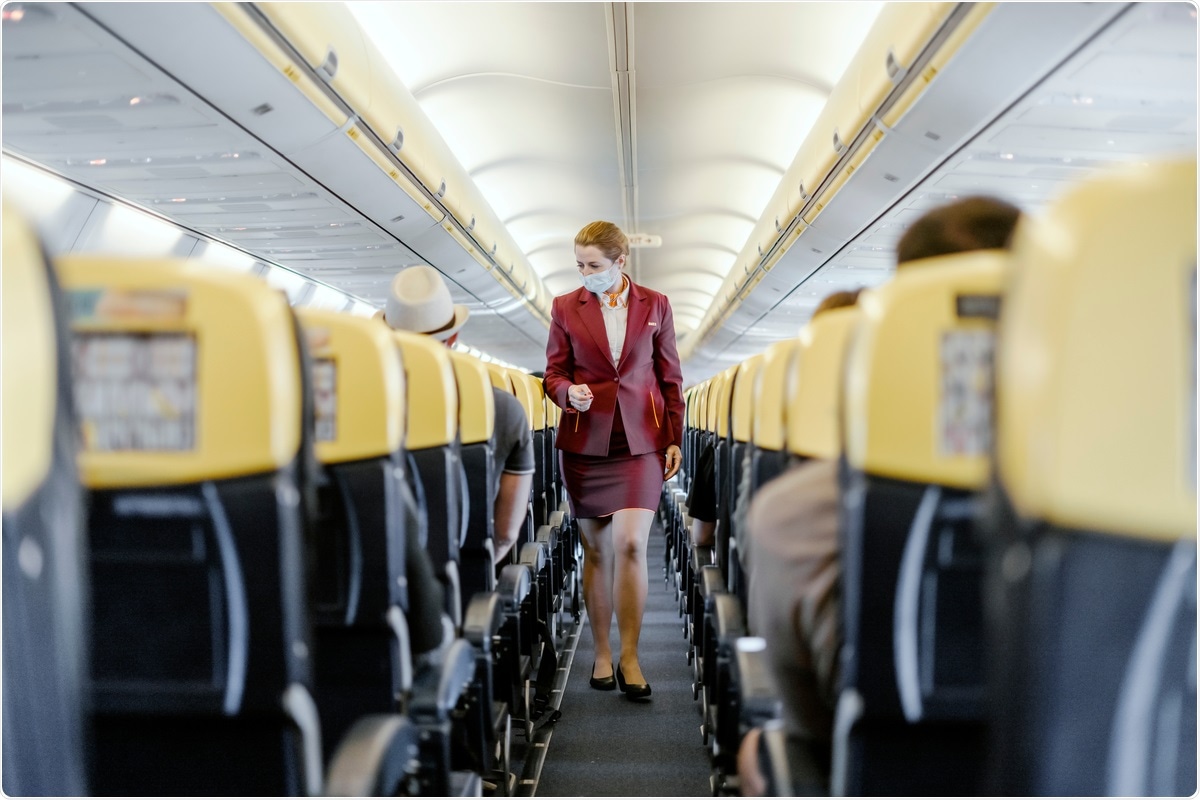A team of US scientists has recently evaluated the risk of severe acute respiratory syndrome coronavirus 2 (SARS-CoV-2) infection among passengers present inside an aircraft cabin. The findings suggest that the risk of airborne viral transmission is minimal during long-duration flights. The study is currently available on the medRxiv* preprint server.

Background
Since its emergence in December 2019, SARS-CoV-2, the causative pathogen of the coronavirus disease 2019 (COVID-19), has already infected more than 92.68 million people and claimed more than 1.98 million lives worldwide. To contain the spread of SARS-CoV-2, several control measures, such as regional or national lockdowns, movement or travel restrictions, and physical distancing, etc., have been implemented to some degree by government bodies of most countries. As a consequence, many countries have faced serious socioeconomic crises. During the later phases of the pandemic, relaxations on control measures have been made to support the economy and overcome the crisis.
After lifts in travel restrictions, airline services have been resumed between in many countries, which raises a question about the risk of viral transmission during travel. Because an airborne transmission of SARS-CoV-2 is possible, the risk of acquiring infection is expected to be higher in enclosed or poorly ventilated places. Thus, it is believed that passengers or airline staff present inside an aircraft cabin for a prolonged period of time might be at higher risk of SARS-CoV-2 infection.
Current study design
In this study, the scientists have tried to quantify the risk of SARS-CoV-2 infection among passengers traveling via two large aircraft (Boeing 767 and 777 airframes). They have used fluorescent and DNA-tagged microspheres to analyze the dispersion and deposition of aerosol particles released from a simulated SARS-CoV-2-infected passenger. Specifically, they have measured the level of aerosols within the breathing zone of fellow passengers who are seating in same row with the simulated infected passenger or in rows ahead or behind the source. They performed these measurements at different locations inside the aircraft, as well as by placing the simulated infected passenger at multiple locations.
Important observations
Boeing 777
By measuring the percentage of particle penetration into the breathing zones, the scientists observed that the maximum exposure occurs in a seat next to the simulated infected passenger. The level of exposure has been found to be lower in seats that are placed in front of the source, whereas seats placed behind the source have a higher exposure level.
With further analysis, they have observed that mixing of contaminants within a row occurs rapidly and that the flow of contaminants is directed toward the aft of the aircraft where the outflow valve is located. In first-class sections where gaps between seats are wide, the level of exposure is found to be lower than the economy section.
Boeing 767
According to the findings, the risk of exposure in Boeing 767 is lower than the Boeing 777. However, both aircraft share similar characteristics of risk exposure. The flow of contaminants toward the aircraft aft is less in Boeing 767. The flow of contaminants released from the aft seat is directed toward the aft, whereas a forward flow is observed for contaminants released from the front-mid seat.
By conducting similar experiments using a simulated infection source with or without masks, about 15% reduction in the particle count has been observed in experiments conducted with a mask.
Study significance
The study findings suggest that there could be a limited risk of exposure to SARS-CoV-2-containing aerosols inside an aircraft due to rapid mixing, dilution, and removal. A lower level of aerosol is observed in the aft section of the aircraft, which indicates a lower risk of exposure. However, it is important to consider that the study findings are based on the simulation of a single source of infection, and thus, the transmission dynamics may vary in conditions with multiple infected passengers. Moreover, the study focuses on aerosols and small particulate matter of 1-3 µm. The transmission dynamics of large respiratory droplets have not been included in the study.
*Important Notice
medRxiv publishes preliminary scientific reports that are not peer-reviewed and, therefore, should not be regarded as conclusive, guide clinical practice/health-related behavior, or treated as established information.
https://news.google.com/__i/rss/rd/articles/CBMieWh0dHBzOi8vd3d3Lm5ld3MtbWVkaWNhbC5uZXQvbmV3cy8yMDIxMDExNC9XaGF0LWFyZS10aGUtZHluYW1pY3Mtb2YtU0FSUy1Db1YtMi10cmFuc21pc3Npb24taW5zaWRlLWFuLWFpcmNyYWZ0LWNhYmluLmFzcHjSAX1odHRwczovL3d3dy5uZXdzLW1lZGljYWwubmV0L2FtcC9uZXdzLzIwMjEwMTE0L1doYXQtYXJlLXRoZS1keW5hbWljcy1vZi1TQVJTLUNvVi0yLXRyYW5zbWlzc2lvbi1pbnNpZGUtYW4tYWlyY3JhZnQtY2FiaW4uYXNweA?oc=5
2021-01-14 19:07:00Z
CAIiEEICGmXwe2bvQtK-yN9csSgqMwgEKioIACIQZdRflS9INK7zM5FkBi3R3CoUCAoiEGXUX5UvSDSu8zORZAYt0dwwr47MBg
Bagikan Berita Ini














0 Response to "What are the dynamics of SARS-CoV-2 transmission inside an aircraft cabin? - News-Medical.Net"
Post a Comment